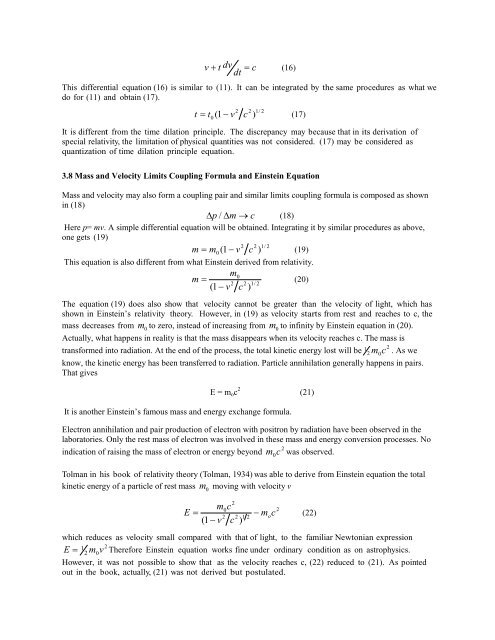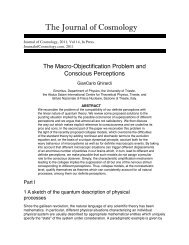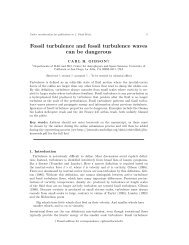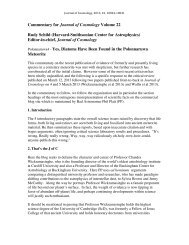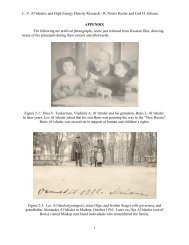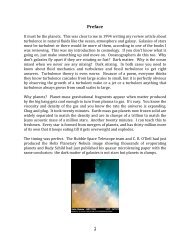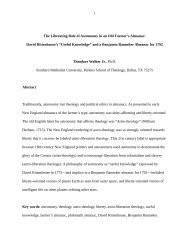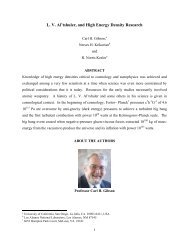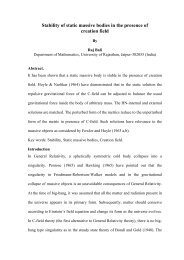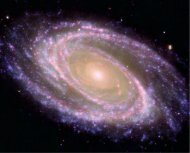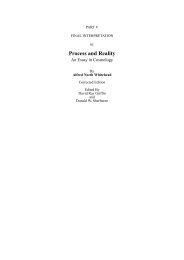The Quantization of Classical Fields Equations and the Cyclic ...
The Quantization of Classical Fields Equations and the Cyclic ...
The Quantization of Classical Fields Equations and the Cyclic ...
Create successful ePaper yourself
Turn your PDF publications into a flip-book with our unique Google optimized e-Paper software.
v + t dv = c (16)<br />
dt<br />
This differential equation (16) is similar to (11). It can be integrated by <strong>the</strong> same procedures as what we<br />
do for (11) <strong>and</strong> obtain (17).<br />
t −<br />
2 2 1/<br />
2<br />
= t0<br />
( 1 v c ) (17)<br />
It is different from <strong>the</strong> time dilation principle. <strong>The</strong> discrepancy may because that in its derivation <strong>of</strong><br />
special relativity, <strong>the</strong> limitation <strong>of</strong> physical quantities was not considered. (17) may be considered as<br />
quantization <strong>of</strong> time dilation principle equation.<br />
3.8 Mass <strong>and</strong> Velocity Limits Coupling Formula <strong>and</strong> Einstein Equation<br />
Mass <strong>and</strong> velocity may also form a coupling pair <strong>and</strong> similar limits coupling formula is composed as shown<br />
in (18)<br />
∆ p / ∆m<br />
→ c (18)<br />
Here p= mv. A simple differential equation will be obtained. Integrating it by similar procedures as above,<br />
one gets (19)<br />
2 2 1/<br />
2<br />
m = m0<br />
( 1−<br />
v c ) (19)<br />
This equation is also different from what Einstein derived from relativity.<br />
m0<br />
m = (20)<br />
2 2 1/<br />
2<br />
( 1−<br />
v c )<br />
<strong>The</strong> equation (19) does also show that velocity cannot be greater than <strong>the</strong> velocity <strong>of</strong> light, which has<br />
shown in Einstein’s relativity <strong>the</strong>ory. However, in (19) as velocity starts from rest <strong>and</strong> reaches to c, <strong>the</strong><br />
mass decreases from 0 m to zero, instead <strong>of</strong> increasing from m0 to infinity by Einstein equation in (20).<br />
Actually, what happens in reality is that <strong>the</strong> mass disappears when its velocity reaches c. <strong>The</strong> mass is<br />
2<br />
transformed into radiation. At <strong>the</strong> end <strong>of</strong> <strong>the</strong> process, <strong>the</strong> total kinetic energy lost will be 1<br />
2 m 0c<br />
. As we<br />
know, <strong>the</strong> kinetic energy has been transferred to radiation. Particle annihilation generally happens in pairs.<br />
That gives<br />
E = moc 2 (21)<br />
It is ano<strong>the</strong>r Einstein’s famous mass <strong>and</strong> energy exchange formula.<br />
Electron annihilation <strong>and</strong> pair production <strong>of</strong> electron with positron by radiation have been observed in <strong>the</strong><br />
laboratories. Only <strong>the</strong> rest mass <strong>of</strong> electron was involved in <strong>the</strong>se mass <strong>and</strong> energy conversion processes. No<br />
indication <strong>of</strong> raising <strong>the</strong> mass <strong>of</strong> electron or energy beyond m was observed.<br />
Tolman in his book <strong>of</strong> relativity <strong>the</strong>ory (Tolman, 1934) was able to derive from Einstein equation <strong>the</strong> total<br />
kinetic energy <strong>of</strong> a particle <strong>of</strong> rest mass m 0 moving with velocity v<br />
m c<br />
( 1−<br />
v c<br />
2<br />
0c<br />
2<br />
E = 0<br />
2 2<br />
2<br />
− m c<br />
1 2 o (22)<br />
)<br />
which reduces as velocity small compared with that <strong>of</strong> light, to <strong>the</strong> familiar Newtonian expression<br />
2<br />
E = 1<br />
2 m0v<br />
<strong>The</strong>refore Einstein equation works fine under ordinary condition as on astrophysics.<br />
However, it was not possible to show that as <strong>the</strong> velocity reaches c, (22) reduced to (21). As pointed<br />
out in <strong>the</strong> book, actually, (21) was not derived but postulated.


